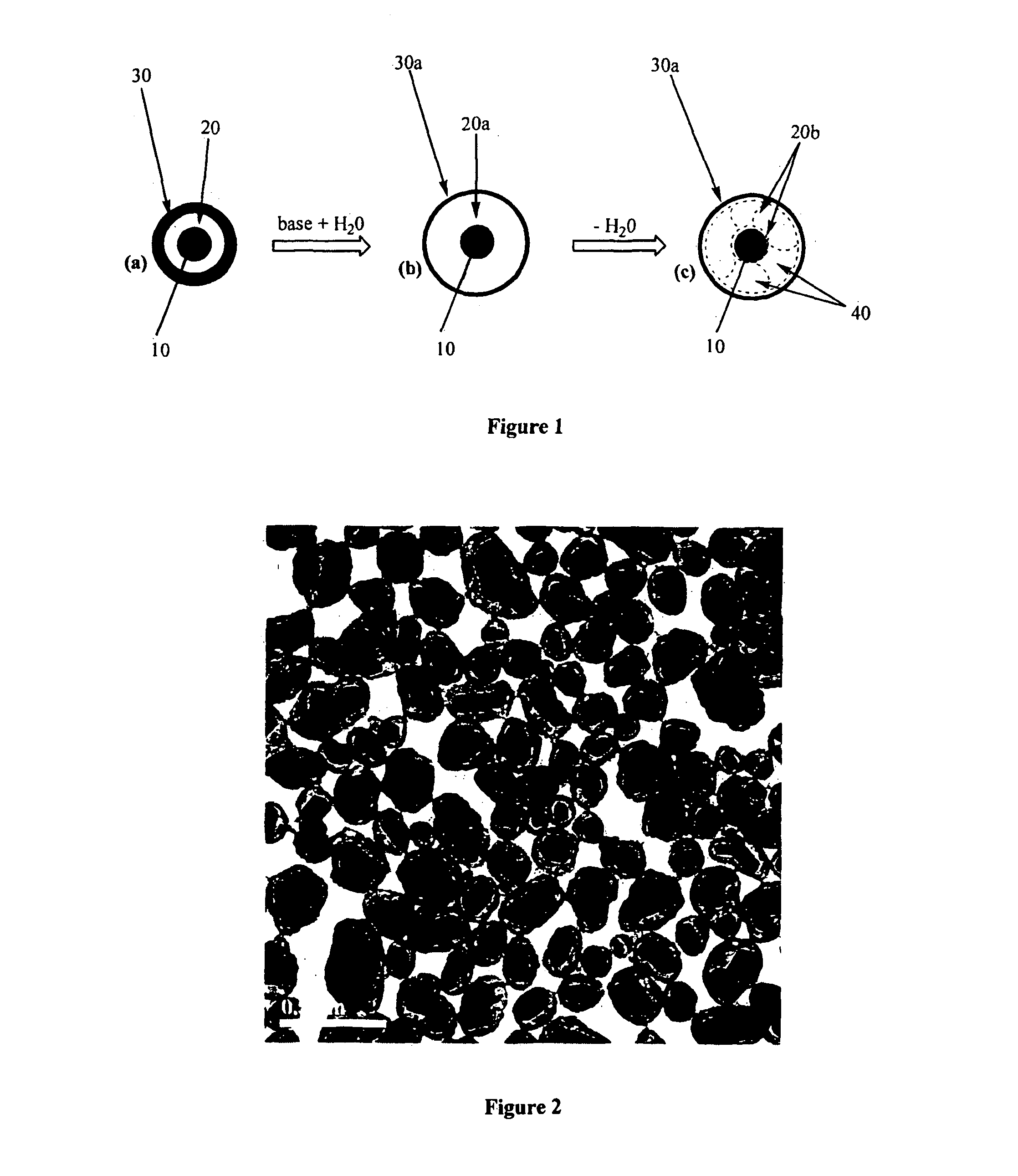Water swellable polymer materials
a polymer material and water-swelling technology, applied in the field of water-swellable polymer particles, can solve the problems of affecting the formation of air voids in the paint film, and the main contributor to paint formulation cost, so as to facilitate uniform and controlled swelling of the swellable polymer layer, enhance the opacification properties of vesiculated polymer particles, and reduce the volume of th
- Summary
- Abstract
- Description
- Claims
- Application Information
AI Technical Summary
Benefits of technology
Problems solved by technology
Method used
Image
Examples
example 1
Example 1a
Preparation of a poly-[(4-styrenesulfonic acid)-co-(acrylic acid)] macro-RAFT Agent Containing an Average of 15 Monomer Units Per Chain in a Molar Ratio of 1:2 Using 2-{[(butylsulfanyl)carbonothioyl]sulfanyl}propanoic Acid
[0250]2-{[(butylsulfanyl)carbonothioyl]sulfanyl}propanoic acid (1.2 g, 5.03 mmol), 4,4′-azobis(4-cyanovaleric acid) (V501) (0.072 g, 0.43 mmol), acrylic acid (3.63 g, 50.34 mmol), 4-styrenesulfonic acid (5.19 g, 25.17 mmol) in a mixture of dioxane (10.00 g) and water (10.05 g) was prepared in a 50 mL round bottom flask. This was stirred magnetically and sparged with nitrogen for 10 minutes. The flask was then heated at 70° C. for 3 hours under constant stirring. The final copolymer solution had 29.3% solids.
example 1b
Preparation of Water Swellable Polymer Encapsulated Particulate Material Using the Macro-RAFT Agent from 1a
Dispersing the Particulate Material:
[0251]In a 100 ml beaker, macro-RAFT solution from Example 1a (1.61 g, 0.27 mmol) was dispersed in water (50 g) to yield a yellow solution of pH 2.22. Ammonia (28% solution in water) was added to the solution to increase the pH to 4.05. Titanium dioxide (Tioxide TR92, Huntsman) (10.04 g) was added to the solution and was thoroughly dispersed using a Vibra-Cell Ultrasonic Processor (Sonics and Materials, Inc.) standard probe at an amplitude of 30% for 5 minutes.
Forming the Water Swellable Layer:
[0252]After sonication, the dispersion was transferred to a 100 mL round bottom flask containing 4,4′-azobis(4-cyanovaleric acid) (0.025 g) which was subsequently sealed and purged with nitrogen for 15 min. The whole flask was immersed in an oil bath with a temperature setting of 70° C. A 1:1:1 (weight ratio) solution of methyl methacrylate, butyl acryl...
example 2
Example 2a
Preparation of a poly-[(4-styrenesulfonic acid)-co-(acrylic acid)-co-(butyl acrylate)] macro-RAFT Agent Containing an Average of 19 Monomer Units Per Chain in a Molar Ratio of 5:10:4 Using 2-{[(butylsulfanyl)carbonothioyl]sulfanyl}propanoic Acid
[0258]2-{[(butylsulfanyl)carbonothioyl]sulfanyl}propanoic acid (1.2 g, 5.0 mmol), 4,4′-azobis(4-cyanovaleric acid) (V501) (0.074 g, 0.3 mmol), acrylic acid (3.64 g, 50.5 mmol), 4-styrenesulfonic acid (5.19 g, 25.2 mmol), butyl acrylate (2.64 g, 20.6 mmol) in a mixture of dioxane (10.00 g) and water (10.69 g) was prepared in a 50 mL round bottom flask. This was stirred magnetically and sparged with nitrogen for 10 minutes. The flask was then heated at 70° C. for 12 hours under constant stirring. The final copolymer solution had 34.9% solids.
PUM
| Property | Measurement | Unit |
|---|---|---|
| sizes | aaaaa | aaaaa |
| Tg | aaaaa | aaaaa |
| Tg | aaaaa | aaaaa |
Abstract
Description
Claims
Application Information
 Login to View More
Login to View More - R&D
- Intellectual Property
- Life Sciences
- Materials
- Tech Scout
- Unparalleled Data Quality
- Higher Quality Content
- 60% Fewer Hallucinations
Browse by: Latest US Patents, China's latest patents, Technical Efficacy Thesaurus, Application Domain, Technology Topic, Popular Technical Reports.
© 2025 PatSnap. All rights reserved.Legal|Privacy policy|Modern Slavery Act Transparency Statement|Sitemap|About US| Contact US: help@patsnap.com



